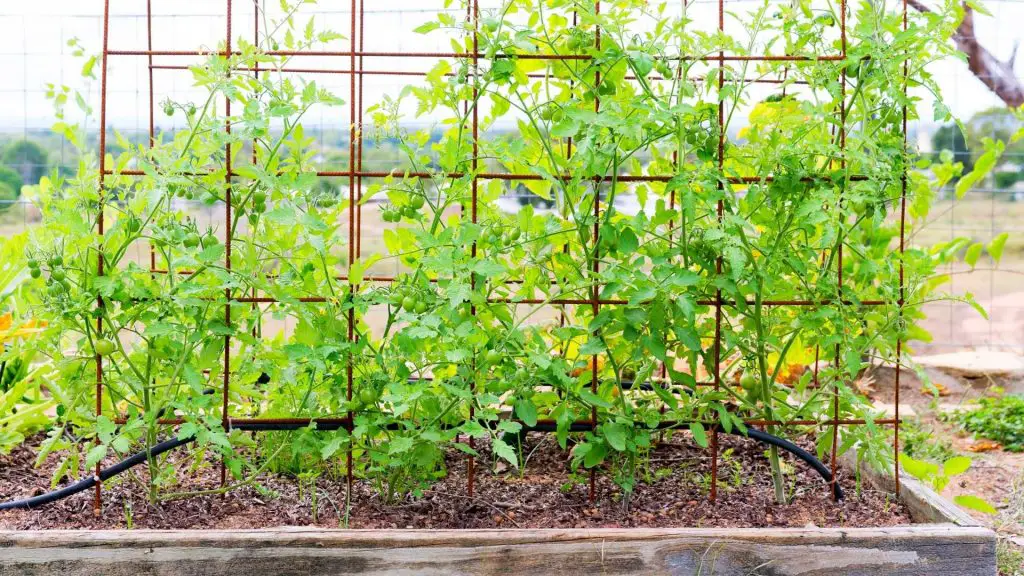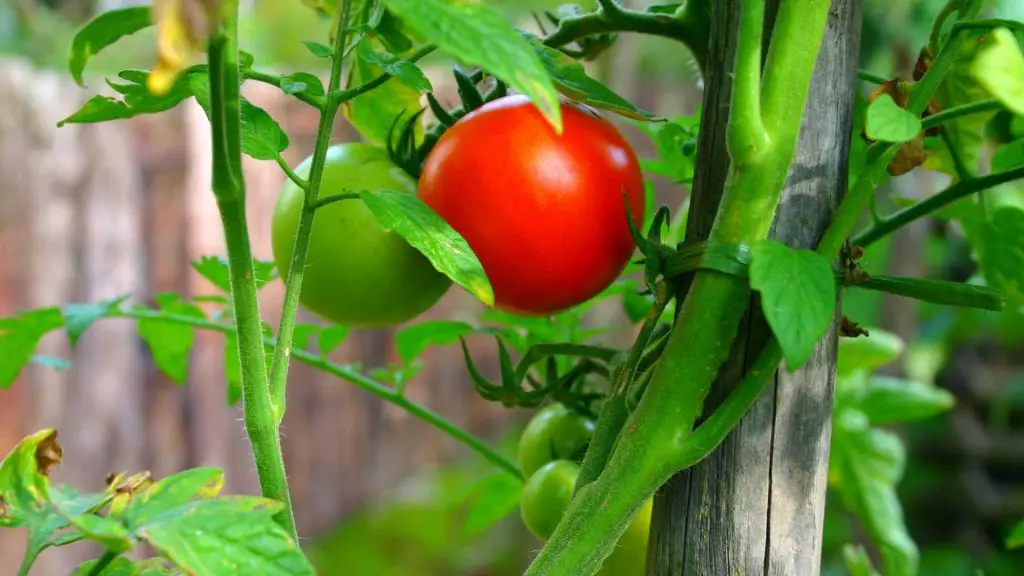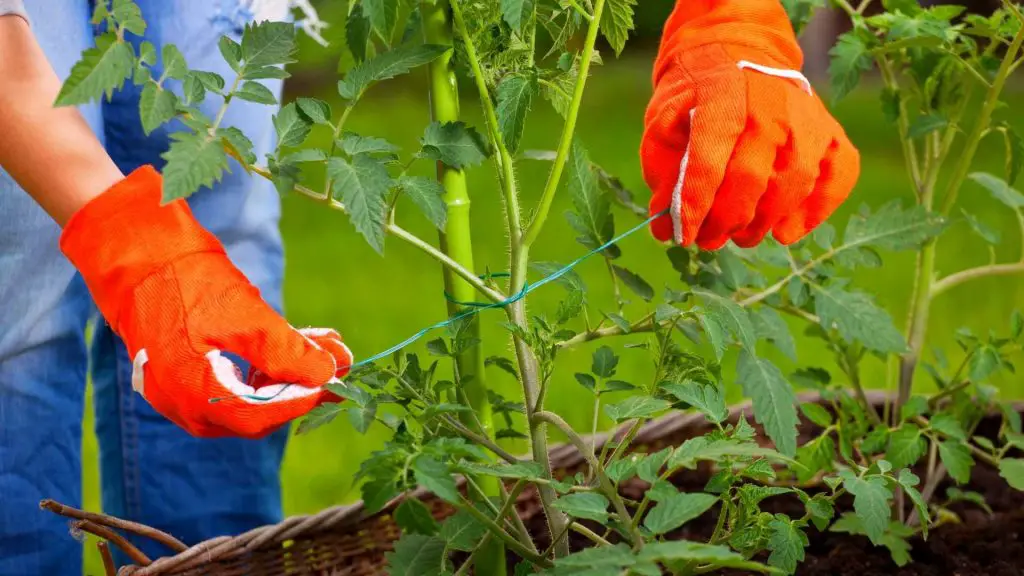Tomatoes are a common part of vegetable gardens. A raised bed is a good option for growing tomatoes. But tomato plants need support to grow well. When your seedlings start growing in the raised bed the next step is how to support them.
It is not an easy task to keep your tomato plants healthy. There are different ways of providing support to tomato plants. It is up to you which method you prefer.
If you have ample room then you can choose cage-type tomato support. In this way, tomato vines will get proper support and there is no need for pruning or tying the stems. You can easily surround the plant and no need to tie. But standard cages are too restrictive and are not tall enough.

If you have a small space then you can also use a tomato ladder to provide support to your tomato plants. It is perfect for any type or variety. In this type, you can easily access your plant for pruning and harvesting.
But in this article, we are going to discuss how to stake tomato plants in a raised bed. With the help of staking your tomato plants will produce large and healthy fruit.
This is a simple way of providing support to tomatoes. The system of staking depends on the type of tomato plants which you are growing in your raised bed.
TYPES OF TOMATOES
Tomatoes have two main groups, one is determinate variety and the other is an indeterminate variety. We will discuss both varieties one by one.
DETERMINATE TOMATOES
These are less aggressive vines that can produce fruit within a short period. They can grow well if you don’t arrange support for them but it can be risky for the healthy growth of your plants.
Because staking of tomato plants makes it possible that your plants get proper air and sunlight. Stalking will provide support to plants to hold excess weight of fruit and prevent them from accidentally tipping.
INDETERMINATE TOMATOES
This variety grows taller and produces fruit slowly in the growing season. This type is different from the determinate variety as without support this variety will die.
Heavy vines of this variety can bend or break due to the weight of fruits. Staking is necessary for balancing the tomato plants. Air and sunlight will be easily available for your plants after staking.
STAKING TOMATOES

Tomatoes will grow well when they get support. When less space is available between the plants so you can’t adjust the cages for support then simply stake tomatoes.
Staking will help in the upward growth of tomato plants. A support structure will help to keep insects away and at the same time prevent your plants from many diseases. The structure of the support should be made from durable and weather-resistant materials.
So it can hold the weight of the fruit. The durable structure will last for many years. You should install that structure that is easy to install, cheap and you can maintain it easily.
STAKING OPTIONS: There are many options for staking.
SINGLE-STAKE SYSTEM

The simple and easy way of providing support to the tomato plants is a single-stack system. Place the stake within an inch or two at the base of the tomato plant’s stem. The stake should be inserted 6 inches deep in the soil of the raised bed, this will provide strong support.
Stakes can be made from wood, metal, or plastic. If you use metal for staking then it will last many years for its durability. When the height of the tomato plant is 10 to 12 inches, this is the best time for staking.
You can use garden twigs, strips of fabric, or a piece of pantyhose for tying stakes. You can stake your tomato plant about every 8 inches. One drawback of the single-stake system is that it can provide less support to your tomato plants.
As determinate varieties are not so tall so it is best to use this system for them. Indeterminate variety needs a more supportive structure when the fruits get larger.
DOUBLE STAKING SYSTEM
It is not difficult to create a double stake system, just add a second stake to the single stake. Place the stakes on opposite sides, each stake is tied around the plant to secure it.
Like a single-stake system, stake the plant about every 8 inches so the air can reach every part of the plant. In the same way, sunlight also reaches the plants evenly and harvesting becomes easier.
FLORIDA WEAVE
In this method, you will give support to your tomato plants only by using a strong string. Grow your tomato plants in a row leaving suitable space between each plant. Your stakes should fix in the soil very deeply in your raised bed.
The place where you should fix the stakes in the soil is at the end of the rows of tomato plants and in between every third or fourth tomato plant. The material of the stakes depends on your choice but metal T-posts are very durable and effective than wooden stakes.
When stakes are fixed in the raised bed then take a strong and durable string. Now start tying the string around the end of the posts but one or two inches above the surface of the soil.
After that weave the string in and out between each tomato plant. Your string should be tight enough to give strong support to vines. You should loop the string around each middle post so the plant can hold the weight of the fruit.
When you reach the end of the row then cut the string and tie it to the stake which is fixed at that place. Now repeat this step but the opposite side of the plant as it was the time before. Make sure there should be 1 or 2 inches of gap between each set of string.
This technique is famous amongst growers because it saves your time and requires few resources. If you are growing just a couple of tomatoes or an unending row, this system will work great.
Purchase Tomato Cages From Gardeners Supply Company
HOW TO STAKE TOMATO PLANTS WITH BAMBOO?

If you leave the tomatoes on the branches of the plant then you will see the branches will bend down due to the weight of the fruit. Plants will grow healthy if they grow upright.
If tomatoes are left unsupported then the plant can fall, the stem may break and even the fruit sits on the soil. As a result, the fruit will become food for pests and all your hard work will be lost.
Now we will learn how to stake tomato plants with bamboo poles, these strong and sturdy poles give the stem of tomato required support. Stakes make it possible that you can grow more plants in a small place. Follow all the steps to stake your plants.
STEP 1
Take the bamboo stake and push it 12 Inches into the raised bed but 2 to 3 inches away from the stem of your tomato plant. The diameter of the bamboo stake should be 1 inch and 6 feet tall.
It is perfect for determinate variety because the height of the determinate variety is about 8 feet. It is best to fix the stake after planting the seeds or seedlings in a raised bed because, in this way, you can prevent the roots of tomato plants from damage.
STEP 2
After fixing the stem, now tie the main stem of tomato plants with a strong stem to the stake. The height of the plant must be 12 inches when you start tying. Loop a string and tie around the stem but tie the stem loosely so that it will not hurt your plant.
STEP 3
As your tomato plant grows, you can add new tiles to the main stem. There should be an interval of 8 to 12 inches between each tie. Make sure the ties are placed above the branches which hold flowers and fruits. The reason is that if the stem slips through the tie the fruit will not strip from the branch.
STEP 4
If you see the sucker on the branch then pinch-off them as it will prevent your plants and make it easy for you to train your plants to the stake. If you are growing an indeterminate variety then pinch back the tips of lateral branches because the leaves of this variety are very large.
Remember if you are growing determinate variety then don’t pinch the branches because it may reduce flowers and fruits.
Purchase Tomato Cages From Gardeners Supply Company
Staking is good for small spaces and affordable. You can easily maintain your plants with the help of stakes. But your plants need frequent pruning in the staking system. Whatever support technique you choose for your tomato plants, all the ways will help your plant to grow healthy.

